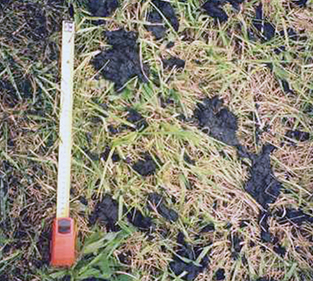
Determination of Bisphenol A
Biosolids post application.
Bisphenol A, or BPA, is a high production volume chemical widely used in manufacturing polycarbonate plastics and epoxy resins that are used in many industries. Procedures described in a new ASTM International standard will be used for measuring BPA concentration in environmental media such as soils, sludges and biosolids.
The new standard, D7858, Test Method for Determination of Bisphenol A in Soil, Sludge and Biosolids by Pressurized Fluid Extraction and Analyzed by Liquid Chromatography/Tandem Mass Spectrometry, is under the jurisdiction of D34.01.06 on Analytical Methods, a part of ASTM International Committee D34 on Waste Management.
Lawrence Zintek, Ph.D., a chemist with the U.S. Environmental Protection Agency Region 5 Chicago Regional Laboratory, and a D34 member, says that humans appear to be exposed to BPA primarily through food packaging. BPA is also found in environmental waters, sediments, biosolids and sludge from leaching out of common everyday products. The land application of biosolids/sludge, which has been shown to contain BPA, could lead to elevated levels of BPA in waterways/sediments from run-off from these fields during rain events.
"Members of the public, including industry, nongovernment organizations, governments and citizens routinely request information regarding the BPA content of products and BPA's presence in the environment, making this standard extremely useful for various sampling strategies," says Zintek.
In addition, Zintek notes that the standard will be used in work that EPA does and may be complimentary with other U.S. federal agencies' investigations in assessing health risks, including the Food and Drug Administration, the Centers for Disease Control and Prevention, and the National Institute of Environmental Health Sciences. The work being done by these agencies will better determine and evaluate the human health consequences of BPA exposures.
Along with D7574, Test Method for Determination of Bisphenol A in Environmental Waters by Liquid Chromatography/Tandem Mass Spectrometry (approved by ASTM International Committee D19 on Water in 2009), D7858 is used by the EPA for analysis of biosolid, soil and water samples to determine BPA. The procedures described in D7574 and the new D7858 were originally developed by the Chicago Regional Laboratory of the EPA. D34.01 will be conducting interlaboratory validation testing to be completed by 2014.
To purchase ASTM standards, visit www.astm.org and search by the standard designation, or contact ASTM Sales (phone: 877-909-ASTM; sales@astm.org).
CONTACT Technical Information: Lawrence Zintek, Ph.D., U.S. Environmental Protection Agency Region 5 Chicago Regional Laboratory • Chicago, Ill. • Phone: 312-886-2925 | ASTM Staff: Alyson Fick • Phone: 610-832-9710 | Upcoming Meeting: Oct. 10-11 (virtual meeting)
 SN Home
SN Home Archive
Archive Advertisers
Advertisers Masthead
Masthead RateCard
RateCard Subscribe
Subscribe Email Editor
Email Editor